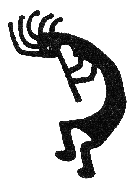Compiled by Karen Arnason, Mhairi(Vi) Maeers,
Judith McDonald and Harley Weston
Games constructed by Christine Treptau

Around the world people have passed on games as part of their culture. Both children and adults played games in all Aboriginal nations, and because most relied on symbols, these games could be played among different nations who didn't speak the same language. Many of these games were played for entertainment, but they usually had a religious meaning or were used as learning tools. These games also were symbolic of the season; many of the games were specific for summer or winter.
Through the use of these games, people would be developing hunting, problem solving and strategy skills. However, by taking a closer look at a few of these activities you can see that the educational value extends beyond the obvious skills they were meant to teach. Players were learning many basic mathematical concepts while enjoying these games. The idea of patterns, relationships of patterns, numbers and operations were developed in many of the dice games. Also, the strategy games brought in ideas of problem solving and critical thinking. Practically all of these games rely on the concepts of data management and probability.
There are three categories or types of games that we look at in this project - games of chance, games of strategy and lifestyle based mathematics. The games of chance that are shown in this project mostly deal with dice and gambling. In such games as, "Hubbub" or the "Stick game" players use different patterns to represent point values. This concept builds on the idea of patterns and the relationships of the patterns and the ideas of probability. These games also use counting sticks as a source of data management. Experimentation with ideas of data management are also apparent by comparing games like "Throw sticks", where the data depends on place value, and "Bowl & Dice", where different types of sticks hold different point values.
If we take a look at the two strategy games you can see different mathematical concepts developing. In "Awithlaknannai", there is again a different data management source through the collecting of the opponents' markers. You can also see how both "Picaria" and "Awithlaknannai" develop problem solving skills and critical thinking as you try to outwit your opponent.
These games will work well in classrooms to meet educational objectives. They are significant examples of a natural learning environment and the mathematical concepts that can be abstracted from them.
 GAMES OF CHANCE
GAMES OF CHANCE 
- Kutepuchkunuputuk- Stick Guessing
- Ahkitaskoomnahmahtowinah - Counting Sticks
- Stick Dice
- Chekutnak - Stick Dice
- Hubbub
- "Wa'lade hama'gan" - Bowl & Dice
- Throw Sticks
- Stick Game
- Ball & Triangle
- Stick Flipping
 GAMES OF STRATEGY
GAMES OF STRATEGY 
 LIFESTYLE
LIFESTYLE 
 OTHER INFORMATION
OTHER INFORMATION 
Return to Math Central |
To return to the previous page use your browser's back button.